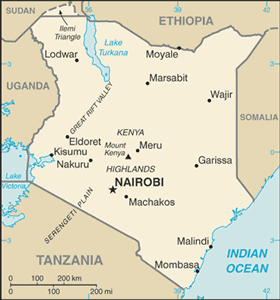The Geography of Kenya
The Geography of Kenya
Kenyan Geography
Location: Eastern Africa, bordering the Indian Ocean, between Somalia and Tanzania
Geographic coordinates: 1 00 N, 38 00 E
Map references: Africa
Area: total: 582,650 sq km land: 569,250 sq km water: 13,400 sq km
Area - comparative: slightly more than twice the size of Nevada
Land boundaries: total: 3,477 km border countries: Ethiopia 861 km, Somalia 682 km, Sudan 232 km, Tanzania 769 km, Uganda 933 km
Coastline: 536 km
Maritime claims: territorial sea: 12 nm exclusive economic zone: 200 nm continental shelf: 200 m depth or to the depth of exploitation
Climate: varies from tropical along coast to arid in interior
Terrain: low plains rise to central highlands bisected by Great Rift Valley; fertile plateau in west
Elevation extremes: lowest point: Indian Ocean 0 m highest point: Mount Kenya 5,199 m
Natural resources: limestone, soda ash, salt, gemstones, fluorspar, zinc, diatomite, gypsum, wildlife, hydropower
Land use: arable land: 8.01% permanent crops: 0.97% other: 91.02% (2005)
Irrigated land: 1,030 sq km (2003)
Natural hazards: recurring drought; flooding during rainy seasons
Environment - current issues: water pollution from urban and industrial wastes; degradation of water quality from increased use of pesticides and fertilizers; water hyacinth infestation in Lake Victoria; deforestation; soil erosion; desertification; poaching
Environment - international agreements: party to: Biodiversity, Climate Change, Climate Change-Kyoto Protocol, Desertification, Endangered Species, Hazardous Wastes, Law of the Sea, Marine Dumping, Marine Life Conservation, Ozone Layer Protection, Ship Pollution, Wetlands, Whaling signed, but not ratified: none of the selected agreements
Geography - note: the Kenyan Highlands comprise one of the most successful agricultural production regions in Africa; glaciers are found on Mount Kenya, Africa's second highest peak; unique physiography supports abundant and varied wildlife of scientific and economic value


